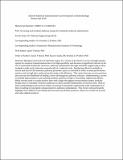Screening and modular design for metabolic pathway optimization
Author(s)
Boock, Jason; Gupta, Apoorv; Jones, Kristala L.
DownloadPrather_Screening and.pdf (1.903Mb)
PUBLISHER_CC
Publisher with Creative Commons License
Creative Commons Attribution
Terms of use
Metadata
Show full item recordAbstract
Biological conversion of substrate sugars to a variety of products is an increasingly popular option for chemical transformation due to its high specificity and because of significant interest in the use of renewable feedstocks. However, pathway optimization through metabolic engineering is often needed to make such molecules economically at a relevant scale. Employing effective methods to search and narrow the immense pathway parameter space is essential to meet performance metrics such as high titer, yield and productivity with efficiency. This review focuses on two practices that increase the likelihood of finding a more advantageous pathway solution: implementing a screen to identify high producers and utilizing modular pathway design to streamline engineering efforts. While screens seek to couple product titer with a high-throughput measurement output, modular design aims to rationally construct pathways to allow parallel optimization of various units. Both of these methodologies have proven widely successful in metabolic engineering, with combinations of them resulting in synergistic enhancements to pathway optimization. This review will particularly highlight their utility for microbially derived acid and alcohol products, which are of interest as fuels and value added products.
Date issued
2015-10Department
Massachusetts Institute of Technology. Department of Biological Engineering; Massachusetts Institute of Technology. Department of Chemical EngineeringJournal
Current Opinion in Biotechnology
Publisher
Elsevier
Citation
Boock, Jason T, Gupta, Apoorv, and Prather, Kristala L J. “Screening and Modular Design for Metabolic Pathway Optimization.” Current Opinion in Biotechnology 36 (December 2015): 189–198. © 2015 Elsevier Ltd
Version: Author's final manuscript
ISSN
0958-1669